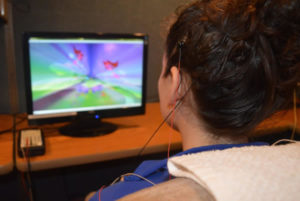Misophonia is a highly complex condition.
Initially, many scientists were skeptical that it even existed. Eventually, though, they started to accept and know more about this ailment. Today, researchers continue seeking a better understanding to help sufferers.
 For instance, it was previously thought that misophonia is a disorder of the auditory processing system and that trigger sounds lead directly to an emotional response—fear, stress, anxiety, or intense anger and aggression. In recent years, though, studies have shown that misophonia includes both an initial physical reflex (flinch or muscle contraction) that precedes the stress response (increased heart rate, sweating, muscle tension) and the emotional reaction.
For instance, it was previously thought that misophonia is a disorder of the auditory processing system and that trigger sounds lead directly to an emotional response—fear, stress, anxiety, or intense anger and aggression. In recent years, though, studies have shown that misophonia includes both an initial physical reflex (flinch or muscle contraction) that precedes the stress response (increased heart rate, sweating, muscle tension) and the emotional reaction.
Continuous research into understanding and treating misophonia has greatly benefited from quantitative Electroencephalogram (qEEG), or brain mapping. These brain maps can shed a lot of light on areas in the brain that suffer from irregular patterns when processing sound.
I found that utilizing this technology in my practice to treat misophonia has been very beneficial. By offering qEEG recording and swLoRETA neurofeedback, I can provide my clients with a more comprehensive treatment plan.
How so?
Outlining an In-Depth Approach to Treating Misophonia
To address misophonia symptoms, therapists have availed themselves of a variety of treatment approaches. These include Cognitive-Behavioral Therapy (CBT), Dialectical Behavior Therapy (DBT), Hypnotherapy, Tinnitus Retraining Therapy (TRT), Neurofeedback, and more.
However, in my practice, we have found that due to the complexity of the disorder a more comprehensive therapeutic approach is needed. Therefore, my current method is based on a multi-fold approach: using CBT to help handle trigger sounds, retraining perception of trigger sounds to reduce sensitivity, and incorporating the Tomatis method to reshape how the brain relates to misophonia symptoms.
Of course, every client’s situation is different. That’s why we perform an in-depth assessment of their unique circumstances and experiences with misophonia. Once we have a complete picture, we can create a customized treatment plan.
Using the Tomatis Method and qEEG swLoRETA Neurofeedback in Correlation
Using the data from the initial evaluation and the qEEG-based neurofeedback recording as tools, I can make an informed treatment recommendation for each individual client. In essence, the information gathered allows me to assess if we should start with the Tomatis method or if neurofeedback would be the better initial choice.
The fact is, both the Tomatis method and neurofeedback have their limitations. Neither can do everything needed to treat complex conditions, such as misophonia. Thus, individuals suffering from these types of issues benefit greatly from this complementary approach.
Quantitative Electroencephalogram (qEEG) Evaluation
You’re probably familiar with an Electrocardiogram (EKG) and how it measures your heart function. A qEEG recording is similar—it’s a non-invasive, high-tech evaluation tool that measures how every area of your brain is functioning. It generates data on the location and frequency of your brain signal performance and how this affects your mental and physical behaviors.
Just like electrodes are placed on certain areas of your body for an EKG, for a qEEG, specialized sensors are put all over your head to read your brain’s signals in real-time. While no two brain patterns are exactly the same, a resting state snapshot is almost identical in all humans. Identical enough to provide a baseline of your brain pattern, which aids in evaluating your condition and recommending a treatment.
Advanced qEEG Evaluation with swLoRETA Neurofeedback
A specific qEEG evaluation method, called swLoRETA neurofeedback, allows for an even deeper exploration of your brain patterns. It provides us with more accurate and in-depth results and, in turn, better analysis of your condition.
The term “swLoRETA” stands for standardized weighted Low-Resolution Brain Electromagnetic Tomography (an improved version of sLoRETA). It is the most advanced calculation and three-dimensional representation that can be accomplished on a qEEG recording.
With this sophisticated tool, we can see exact areas of your brain’s network, including areas that are hyperconnected or lack important connections for optimal functioning. As you can imagine, this type of detailed evaluation is crucial when creating a treatment plan for complex conditions like misophonia.
Tomatis Method Learning to Listen Program
The Tomatis method is a program that helps people learn to listen effectively. While it is often used to address attention and learning deficiencies or developmental issues, it is also a powerful tool to treat misophonia.
By combining the above-mentioned evaluation techniques and the Tomatis method, we can begin retraining the brain’s ability to tolerate and process upsetting trigger sounds. With time, this approach will diminish the impact of these triggers on the sympathetic nervous system.
—
Yes, misophonia is a very complex ailment, and its symptoms will likely never completely go away. Yet, that doesn’t mean you can’t find a measure of relief. Through a combination of in-depth, high-tech evaluation and treatment methods, my clients have seen significant improvements. To read more about misophonia please follow this link https://sacarin.com/misophonia-treatment/
If you would like to take control of your misophonia or learn more about my treatment approach, please feel free to contact me.

